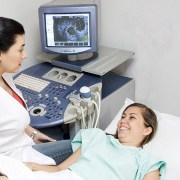 Photo: Getty Images
Photo: Getty Images
Medical technology has come a long way. It seems new machines and instruments are available every day to test us and fix us. From tiny nanobiosensors to large robotic surgical arms, to chemical and genetic technology that personalizes medicine and its delivery ... There are so many new developments that it's impossible for us to know about them all.
But some technology has been in regular use for a long time, and is still used every day. In particular, diagnostic machines and instruments have names that are familiar: x-rays, CT scans, ultrasound, MRIs and PET scans. These are the machines used to test us for many different types of conditions and diseases.
As empowered patients, it's good for us to know what the differences are among these machines, and why our doctors might choose to use one instead of the other to diagnose us.
X-Ray Machines: The first x-ray machine was invented in the late 1800s and is still one of the best diagnostic tools available. It is used for viewing skeletal systems, lungs, blood vessels or intestines. X-rays are quick and painless and produce a negative photograph for the doctor to study.
CT Scanner: Often pronounced "cat scan," CT is the abbreviation for "computerized tomography." That means it combines x-rays with mathematical algorithms to produce three-dimensional pictures of one’s spine, blood vessels, or muscles. CT Scans are also used to identify tumors. The scan itself is painless, and its duration depends on what is being studied.
Ultrasound: If you’ve been pregnant then you’re probably familiar with ultrasound. Sound waves are sent into the body, and changes in the reflection of the sound, called the Doppler effect, produce images which can be viewed on a monitor. Ultrasound is painless and very safe. Besides pregnancy, it is also used to track blood flow through veins and arteries, or may even be used to determine whether you have appendicitis.
MRI: Magnetic resonance imagining makes use of a huge magnet combined with radio waves to examine the internal body and produce incredibly detailed images in either two or three dimensions. MRIs are very noisy, can take a long time, and cannot be used for anyone with metal inside his body, such as a pacemaker or a pinned bone. But they are the test machine of choice when the high level of detail is needed for a diagnosis.
PET Scans: Positron emission tomography, PET scans, are the newest of these diagnostic technologies. They follow chemical changes in the body and are used to track some cancers, analyze several brain disorders, and detect problems in the heart and with blood flow. Patients are injected with a low dose radioactive substance which can be followed through the body by the scanner. They are painless, and depending on the purpose for the test, you may be able to keep your street clothes on.
These are only some of the most well-known diagnostic machines in use today. There are many others, used for more specific purposes, and new ones are being developed. As a smart patient, you should have a good idea of what these machines and instruments are intended to accomplish and how they will help your doctor diagnose you when you experience symptoms.
You can find more complete descriptions and photos of each, plus a much longer list of diagnostic machines and how they are used, at a website called RadiologyInfo, provided by the American College of Radiology and the Radiological Society of North America.
Source:
RadiologyInfo.org-The radiology information resource for patients. Web. 12 Aug. 2011.
http://www.radiologyinfo.org
Reviewed August 12, 2011
by Michele Blackberg R.N.
Edited by Jody Smith





Add a CommentComments
There are no comments yet. Be the first one and get the conversation started!